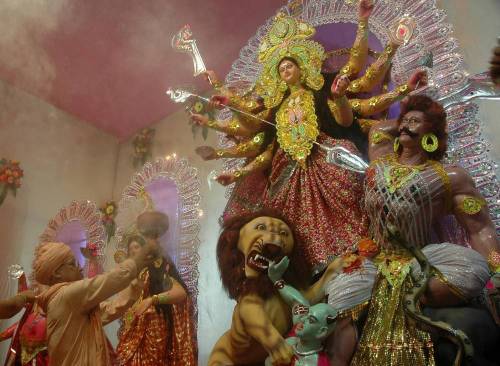Though thousands of miles away, especially during this time of the year, the festive mood of India has got a strong grip on those settled in other parts of the world including the UK. And, one of the most awaited festivals is Durga puja. Several temples and organisations in Leicester, Liverpool, Reading, London and other parts of the UK including Sree Durga Mandir Trust in Manchester are gearing up for Durga Puja celebration with a host of programmes.

- Durga Puja celebration
Durga Puja – one of the most celebrated Hindu festivals in India where devotees worship their mother goddess “Durga Mataji” wears a red saree and has ten arms and, rides a lion. She symbolises women power and leadership. Legends have it that the goddess defeated Mahishasura, the evil buffalo demon.
In West Bengal, this is one of the most celebrated of all festivals. Many beautifully crafted and painted statues of the goddess are made and worshipped during the festival and when it comes to an end, the idols are immersed in the rivers.
The origin of Durga Puja dates back to as early as 16th century AD. The festival, according to the Hindu calendar, is celebrated for 10 days in the month of Ashwin which usually falls in September and October.
Durga Puja celebration involves worshipping of Goddess Durga. The last four days –Saptami, Ashtami, Navami and Dashami (Dasshera) are celebrated with great fervor and aplomb. It is also observed to mark Lord Rama’s first invocation of Goddess Durga when he was preparing to wage war with Ravana, the king of Lanka. However, in the present day context, Durga Puja has evolved into a culture and special occasion for family get-together and social gatherings.
Today, the celebration of Durga Puja has more evolved into popular culture of Bengal and special occasion for family reunion and social gatherings.
Considered as one of the most eventful festivals in India especially in the state of West Bengal, Durga Puja is also referred as Durgotsava.
According to the Hindu religion, Goddess Durga is known by 108 names and reciting all her names during the puja is considered to be auspicious.
Another interesting fact about the festival is Mahalaya—the day of invocation–which is observed a week before Durga Puja. It’s an invitation to the goddess of super power to descent on earth; it is done by chanting mantras. At Amavasya or new moon, people pray to the goddess inviting her to come to the earth to ward off the evil.
On the dawn of Mahalaya, homes especially in West Bengal resonate with the verses of the Chandipath—chanting from ‘Chandi’. In India, Chandipath is aired by All India Radio in the programme ‘Mahisasura Mardini’, narrating the incarnation of Goddess Durga and her fight with Mahishasura. It is in the recorded voice of late Birendra Krishna Bhadra.
Durga Puja festival marks the victory of Goddess Durga over Mahishasura. The festival epitomises that ultimately it is the ‘Good’ that has the last laugh.
@@@@ Anjana Parikh